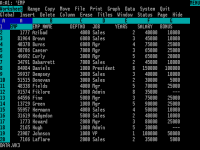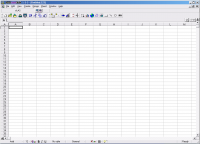'Lotus 1-2-3' er et regnearksprogram fra Lotus Software (nu ejet af IBM). Det var IBM PC'ens første „killer applikation“; its huge popularity in the mid-1980s contributed significantly to the success of the IBM PC in the corporate environment.<ref>http://www.crn.com/it-channel/18818026 Acquired 2007-10-31</ref>
Beginnings
 The Lotus Development Corporation was founded by Mitchell Kapor, a friend of the developers of VisiCalc. 1-2-3 was originally written by Jonathan Sachs, who had written two spreadsheet programs previously while working at Concentric Data Systems, Inc.<ref>http://www.ibm.com/developerworks/lotus/library/ls-NDHistory/ 2007-10-31</ref> To aid its growth, in the UK, and possibly elsewhere, Lotus 1-2-3 was the very first computer software to use television consumer advertising.date=March 2008
The Lotus Development Corporation was founded by Mitchell Kapor, a friend of the developers of VisiCalc. 1-2-3 was originally written by Jonathan Sachs, who had written two spreadsheet programs previously while working at Concentric Data Systems, Inc.<ref>http://www.ibm.com/developerworks/lotus/library/ls-NDHistory/ 2007-10-31</ref> To aid its growth, in the UK, and possibly elsewhere, Lotus 1-2-3 was the very first computer software to use television consumer advertising.date=March 2008
1-2-3 was released on January 26, 1983, started outselling then-most-popular VisiCalc the very same year, and for a number of years was the leading spreadsheet for the DOS operating system. Unlike Microsoft Multiplan, it stayed very close to the model of VisiCalc, including the „A1“ letter and number cell notation, and slash-menu structure. It was free of notable bugs, and was very fast because it was programmed entirely in x86 assembly language and bypassed the slower DOS screen input/output functions in favor of writing directly to memory-mapped video display hardware.
This reliance on the specific hardware of the IBM PC led to 1-2-3 being utilized as one of the two litmus test applications for true 100% compatibility when PC clones started to appear in the early- to mid- 80s. 1-2-3 was used to test general application compatibility, with Microsoft Flight Simulator being used to test graphics compatibility. Because all of a spreadsheet needs to be resident in memory, it also drove the race to utilize more memory, and extended memory and expanded memory techniques were needed to overcome the DOS limit of 640KB to allow larger spreadsheets - this was so important that a memory used/remaining indicator was displayed on-screen.
User features
The name „1-2-3“ stemmed from the product's integration of three main capabilities. Along with being a spreadsheet, it also offered integral charting/graphing and rudimentary database operations.
Data features included sorting data in any defined rectangle, by order of information in one or two columns in the rectangular area. Justifying text in a range into paragraphs allowed it to be used as a primitive word processor.
It had keyboard-driven pop-up menus as well as one-key commands, making it fast to operate. It was also user-friendly, introducing an early instance of context-sensitive help accessed by the F1 key.
 Macros in version one and add-ins (introduced in version 2.0) contributed much to 1-2-3's popularity, allowing dozens of outside vendors to sell macro packages and add-ins ranging from dedicated financial worksheets like F9 to full-fledged word processors. (In the single-tasking MS-DOS, 1-2-3 was sometimes used as a complete environment.) Lotus 1-2-3 supported EGA graphics on the PC/AT and VGA graphics on the PS/2. Early versions used the filename extension „WKS“.<ref>[http://www.fileinfo.com/extension/wks WKS File Extension - Open .WKS files<!– Bot generated title –>]</ref> In version 2.0, the extension changed first to „WK1“,<ref>[http://www.fileinfo.com/extension/wk1 WK1 File Extension - Open .WK1 files<!– Bot generated title –>]</ref> then „WK2“.<ref>[http://www.fileinfo.com/extension/wk2 WK2 File Extension - Open .WK2 files<!– Bot generated title –>]</ref> This later became „WK3“ for version 3.0<ref>[http://www.fileinfo.com/extension/wk3 WK3 File Extension - Open .WK3 files<!– Bot generated title –>]</ref> and „WK4“ for version 4.0.<ref>[http://www.fileinfo.com/extension/wk4 WK4 File Extension - Open .WK4 files<!– Bot generated title –>]</ref>
Macros in version one and add-ins (introduced in version 2.0) contributed much to 1-2-3's popularity, allowing dozens of outside vendors to sell macro packages and add-ins ranging from dedicated financial worksheets like F9 to full-fledged word processors. (In the single-tasking MS-DOS, 1-2-3 was sometimes used as a complete environment.) Lotus 1-2-3 supported EGA graphics on the PC/AT and VGA graphics on the PS/2. Early versions used the filename extension „WKS“.<ref>[http://www.fileinfo.com/extension/wks WKS File Extension - Open .WKS files<!– Bot generated title –>]</ref> In version 2.0, the extension changed first to „WK1“,<ref>[http://www.fileinfo.com/extension/wk1 WK1 File Extension - Open .WK1 files<!– Bot generated title –>]</ref> then „WK2“.<ref>[http://www.fileinfo.com/extension/wk2 WK2 File Extension - Open .WK2 files<!– Bot generated title –>]</ref> This later became „WK3“ for version 3.0<ref>[http://www.fileinfo.com/extension/wk3 WK3 File Extension - Open .WK3 files<!– Bot generated title –>]</ref> and „WK4“ for version 4.0.<ref>[http://www.fileinfo.com/extension/wk4 WK4 File Extension - Open .WK4 files<!– Bot generated title –>]</ref>
 Version 2 introduced macros with syntax and commands similar in complexity to an advanced BASIC interpreter, as well as string variable expressions. Later versions supported multiple worksheets, and were written in C. The charting/graphing routines were written in FORTH by Jeremy Sagan (son of Carl Sagan) and the printing routines by Paul Funk (founder of Funk Software).date=May 2008
Version 2 introduced macros with syntax and commands similar in complexity to an advanced BASIC interpreter, as well as string variable expressions. Later versions supported multiple worksheets, and were written in C. The charting/graphing routines were written in FORTH by Jeremy Sagan (son of Carl Sagan) and the printing routines by Paul Funk (founder of Funk Software).date=May 2008
There is also a version of 1-2-3 for the HP 200LX, a palmtop released by Hewlett-Packard, and a port for Tandy's Deskmate.
Rivals
Lotus 1-2-3 inspired imitators, the first of which was Mosaic Software's „The Twin,“ written in the fall of 1985 largely in the C language, followed by VP-Planner, which was backed by Adam Osborne. These were able to not only read 1-2-3 files, but also execute many or most macro programs by incorporating the same command structure. Copyright law had first been understood to only cover the source code of a program. After the success of lawsuits which claimed that the very „look and feel“ of a program were covered, Lotus sought to ban any program which had a compatible command and menu structure. Program commands had not been considered to be covered before, but the commands of 1-2-3 were embedded in the words of the menu displayed on the screen. 1-2-3 won its case against Mosaic Software. However when they sued Borland over its Quattro Pro spreadsheet, the courts ruled that it was not a copyright violation to merely have a compatible command menu or language. In 1995, the First Circuit found that command menus are an uncopyrightable „method of operation“ under section 102(b) of the Copyright Act. The 1-2-3 menu structure (example, slash File Erase) was itself an advanced version of single letter menus introduced in VisiCalc.
Decline
The rise of Microsoft Windows in the personal computer market was accompanied by the rise in Microsoft's competing spreadsheet, Excel, which gradually surpassed the position of 1-2-3. Lotus initially planned a complete rewrite of the product to overtake Excel, but this project failed to turn out a finished product. 1-2-3 for Windows is still simply a graphical wrapper around the original interface. Additionally, several versions of 1-2-3 were available concurrently, each with different functionality and a slightly different interface.
1-2-3's intended successor, Lotus Symphony, was Lotus's entry into the anticipated „integrated software“ market. It intended to expand the rudimentary all-in-one 1-2-3 into a fully-fledged spreadsheet, graph, database and word processor for DOS, but none of the integrated packages ever really succeeded. 1-2-3 migrated to the Windows platform, where it remains available as part of Lotus SmartSuite. By release 9 of Lotus SmartSuite, 1-2-3 had matched the capabilities of Excel.
Freely available wk4, wk3 File viewer, converter and editors
GNU's spreadsheet program, gnumeric can open and edit wk* files, as well as save it to xls format. A command line program, ssconvert also comes with gnumeric, by which you can perform batch conversion of wk* files into xls format.
See also
References
External links
* [http://www.lotus.com/ Lotus website] * [http://library.thinkquest.org/C0130462/main-1983_lotus.htm 1983 The PC Era–Lotus 1-2-3] * [http://www.aresluna.org/attached/computerhistory/articles/spreadsheets/lotus123review Review of Lotus 123 version 1.0] from December 1982 Byte magazine * [ftp://ftp.lotus.com/pub/lotusweb/product/smartsuite/Kvlotus.exe Free viewer for Lotus SmartSuite products (EXE)] * [http://www.schnarff.com/file-formats/index.html#lotus File Format Documentation for Lotus 1-2-3] * [http://www.cbi.umn.edu/oh/display.phtml?id=356 Oral history interview with Jonathan Sachs] discusses the development of Lotus 1-2-3, Charles Babbage Institute, University of Minnesota